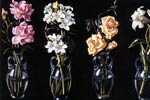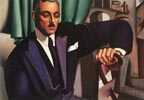
- store
-- search for products associated with Tamara de Lempicka
- vote for Tamara de Lempicka
-- favourite artist
-- favourite epoque
artist: 39487 votes
epoque: 162506 votes
-- viewed 426054 times
pl: Tamara £empicka | |||||||||
There is not a single thing from her biography she didn't colorized at all, sometimes for the public relation purposes, sometimes out of vanity, surely that is why her story of life is as difficult to built as biographies of the masters of early gothic. As a few years old child Lempicka lost her father. It was one of artist's deepest hidden secrets. Official version of Lempicka was that he divorced her mother. More probable, even sure, is that he committed suicide. She grew at her mother's family in Warsaw - cultural capital of this part of former Poland which belonged to tsars' Russia. In 1911 she moved to Petersburg where she joined the high life. She was cutting her time between the lessons of drawing at Petersburg's Academy of Arts and the night life of the city's elite. At one of the parties she met her future husband - Tadeusz Lempicki who's family name she'll make famous and which she'll never stop to use, even after their divorce. They married in 1916. The same year Tamara gave birth to a girl - Maria Krystyna, also known as Kizette. Such easy life would continue for a while if not the October Revolution, but probably it would remain only a complication if not the fact that one early morning of the 1917's winter Bolshevik soldiers came to artist's bedroom and arrested her husband. Few months later they've met in Copenhagen. The price she paid for the freedom of husband and opportunity to leave Russia was spending one night with the Consul of Sweden. After the Bolshevik prison Tadeusz Lempicki never was the man we used to be before. In 1918 Lempicki family moved to Paris. They've rented a small flat, had dunes to pay and lived life which wasn't even similar to the wealth and luxuries they got used to in Russia. Starting studies on Académie Ransom was Lempicka's idea to get a job. She continued her art education in workshops of Maurice Denis and André Lhote of Académie Montparnasse. It seems that the last of her masters - great defender of cubism who used to mix it in his pictures with the French classicism had deciding influence on Lempicka's choice of art direction. If there is a way to define Tamara De Lempicka's art in simple words it would be something between cubism and mature 19'th century European academism. Starting a career wasn't easy -Paris was always full of young woman who wanted to paint. Artist's lifetime are the times of decadence. If we look on her art from this point of view then nevertheless we'll find basic elements of this époque. Artist's style of living was very different from contemporary moral norms. Uncountable affairs with both sexes, even didn't kept in secret. Her art nudes are being claimed as clearly homosexual. Gossip says she was regular visitor of the downtown inns where used to make love with sailors, but who knows if it isn't just another legend invented by Lempicka to show off with her biography? Later, when she was already famous as a portraitist informations and opinions about her paintings were followed by gossips about her latest affairs. Most known was her few months stay in "Il Vittoriale" - fairytale style residence of Italian poet Gabrielo D'Annunzia at the lake of Garda. He wanted Lempicka to be next position on his long list of love trophies, she wanted to portrait a contemporary Casanova. She spend also quiet a while on the studies of the works of the masters of Italian Renaissance. This adventure was main cause of her divorce with Tadeusz Lempicki. Meliated and fed up with wife's affairs Lempicki in 1937 moved to Warsaw. Untouched by Tamara's begging letters and in spite of her three visits in Poland, he ran formal side of divorce, married for a second time and closed this part of his biography. It is untruth that De Lempicka didn't felt connected with Poland. Before second world war she used to show her works as in Paris as in Poland, furthermore -she called herself a Pole till the end of her days. In year 1934 she married baron Roul Kuffner - offspring of the richest family of former Austro-Hungary, met while ordering at Lempicka's a portrait of one of his lovers. Predicting upcoming war in 1938 Lempicka and her husband sold all their gods in Europe and moved to USA in 1939. For almost a decade De Lempicka was true revelation and star, her works were in fashion, everybody wanted to have their portrait on the wall. She got used to company of the Hollywood's greatest stars. Generally she lived the very same way that she did in Europe. But nothing good lass forever - this trivial truth showed once again its unstoppably actuality - in the end of forties surrealism dominated American art and what most important - tastes and wallets of the collectors. She tried to rescue her career by painting surrealistic landscapes, but in this direction she was far from her past mastership and popularity as a portraitist. Show couldn't go on, so she decided to live the stage. She died in Mexico in 1980. For years Lempicka and her artwork were forgotten. The increase of popularity, in other words fashion for art déco brought her works back on the market in late 80's. Memory about decadent artist, "the decadent baroness with a brush" returned. Reproductions of her works were listed in catalogues of the world's top photo agencies, talking and being enchanted by her art became as fashionable and popular as it was in artist's best times. She used to sign her works "Tamara De Lempicka" and painted mainly on panel. Few, most important of Tamara De Lempicka's works need to be mention here. First of all suggestive in way of painting models bodies, double nude "Adam and Eve" containing all typical elements of Lempicka's style. This painting was sold in 1994 at Christie's for 2 million dollars. "The Unfinished Men" is in fact a portrait of Lempicka's first husband Tadeusz Lempicki. Title was given by the artist surely after their divorce, when she decided not to finish it. Unbelievably fantastic is the composition of model's hat and his suit makes an impression that Lempicki can't fit inside picture's frames. It is owned by Musée National d'Art Moderne, Centre Pompidou, Paris. Most popular and famous artist's picture "Self-Portrait in Green Bugatti" was ordered by German fashion magazine "Die Dame"(Lady) after its publisher saw by Lempicka approaching hotel entrance in Sam Marino driving her yellow Renault cabriolet in dress synchronized with its color. She never really had Green Bugatti Atlantic in which she painted herself. It is hard to tell where Lempicka's paintings can be seen, firstly because they are owned mainly by private collections. Couple of them are owned by Polish collectors, three by National Museum in Warsaw, unluckily they aren't available for the visitors. "The Unfinished Man", "Kizette on the Balcony" and "Girl with Gloves" are owned by and exposed in Musée National d'Art Moderne, Centre Pompidou, in Paris. -- this site is also accessible through the addresses: >> www.TamaraLempicka.com >> www.Tamara-Lempicka.com | |||||||||
other URLs: Polish Art.pl ¤ Polish-Art.pl ¤ tworcy.com ¤ rzezbiarze.com ¤ rytownicy.com ¤ Daniel Chodowiecki
¤ TeWa ubezpieczenia Kraków ¤ Daniel Schultz ¤ Marian Ruzamski ¤ Tomasz Wiktor painting















